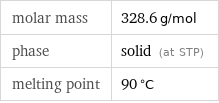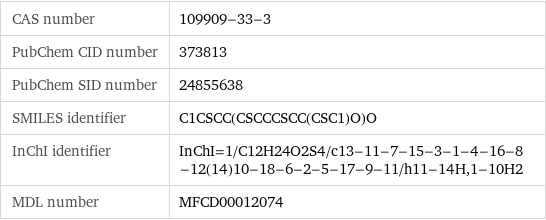Input interpretation

1, 5, 9, 13-tetrathiacyclohexadecane-3, 11-diol, mixture of cis and trans 96%
Chemical names and formulas

formula | C_12H_24O_2S_4 name | 1, 5, 9, 13-tetrathiacyclohexadecane-3, 11-diol, mixture of cis and trans 96% IUPAC name | 1, 5, 9, 13-tetrathiacyclohexadecane-3, 11-diol alternate names | 1, 5, 9, 13-tetrathiacyclohexadecane-3, 11-diol mass fractions | C (carbon) 43.9% | H (hydrogen) 7.36% | O (oxygen) 9.74% | S (sulfur) 39%
Lewis structure

Draw the Lewis structure of 1, 5, 9, 13-tetrathiacyclohexadecane-3, 11-diol, mixture of cis and trans 96%. Start by drawing the overall structure of the molecule: Count the total valence electrons of the carbon (n_C, val = 4), hydrogen (n_H, val = 1), oxygen (n_O, val = 6), and sulfur (n_S, val = 6) atoms: 12 n_C, val + 24 n_H, val + 2 n_O, val + 4 n_S, val = 108 Calculate the number of electrons needed to completely fill the valence shells for carbon (n_C, full = 8), hydrogen (n_H, full = 2), oxygen (n_O, full = 8), and sulfur (n_S, full = 8): 12 n_C, full + 24 n_H, full + 2 n_O, full + 4 n_S, full = 192 Subtracting these two numbers shows that 192 - 108 = 84 bonding electrons are needed. Each bond has two electrons, so the above diagram has all the necessary bonds. There are 42 bonds and hence 84 bonding electrons in the diagram. Lastly, fill in the remaining unbonded electrons on each atom. In total, there remain 108 - 84 = 24 electrons left to draw: Answer: | |
3D structure

3D structure
Basic properties

molar mass | 328.6 g/mol phase | solid (at STP) melting point | 90 °C
Units

Chemical identifiers

CAS number | 109909-33-3 PubChem CID number | 373813 PubChem SID number | 24855638 SMILES identifier | C1CSCC(CSCCCSCC(CSC1)O)O InChI identifier | InChI=1/C12H24O2S4/c13-11-7-15-3-1-4-16-8-12(14)10-18-6-2-5-17-9-11/h11-14H, 1-10H2 MDL number | MFCD00012074